Apollinaire: la poética de lo simultáneo consumada (y III) | Apollinaire: the poetics of the simultaneous consummated (and III)
Como indicara en el post anterior, en esta tercera y última entrega haré un breve comentario del poema ”Zona” de Alcoholes y reproduciré y comentaré poemas de Caligramas.
A propósito del título del libro, destaca Raymond rasgos que caracterizan el decir en Alcoholes: la ebriedad del verbo imaginativo, la incoherencia en las visiones que se conjugan, lo burlesco en la mirada de hechos y personajes…
============
As I indicated in the previous post, in this third and last installment I will briefly comment on the poem "Zone " from Alcohols and I will reproduce and comment on poems from Caligrams.
Regarding the title of the book, Raymond highlights features that characterize the saying in Alcohols: the drunkenness of the imaginative verb, the incoherence of the visions that are conjugated, the burlesque in the look of facts and characters...
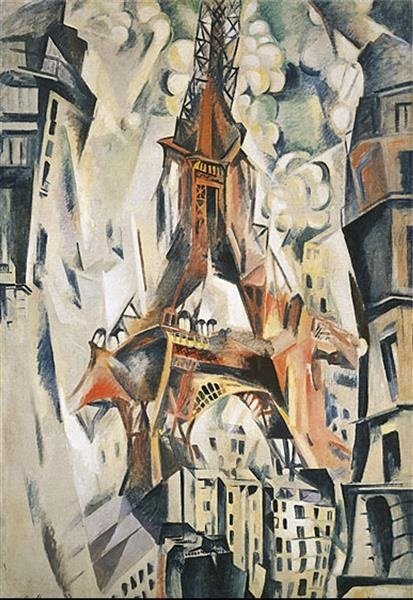
Por su relevancia para la poesía moderna y contemporánea, ”Zona” ha sido un poema que ha tenido muchas y notables interpretaciones; una que aprecio especialmente es la de Ulalume González de León, de quien hemos usado la traducción de “Zona”. De modo que solo sintetizaré ideas ya aportadas por los críticos.
“Zona” está escrito al modo del “libre fluir de la conciencia”, como diría la psicología moderna (modalidad que en narrativa se le llamó “monólogo interior”), es decir, es el discurso mental de un sujeto hablante –en este caso podría identificarse con el propio poeta Apollinaire– que inicia su caminata por París en la mañana, y en ese presente se producirán intercalaciones temporales, sea del pasado a modo de recuerdos o evocaciones –la infancia, la madre, el amigo, la escuela, la iglesia, los amores–, o de un imaginado futuro. Pero también yuxtaposiciones espaciales, quizás en la medida en que el paso por determinados lugares permite la asociación o imaginación de otros espacios no presentes, o con símbolos y objetos muy propios de la civilización en marcha para ese tiempo (por ejemplo, la relación de la elevación de Cristo con el vuelo de un aviador y de múltiples aves).
El poema cierra cuando el sujeto poético vuelve a casa, pues ya está cerrando el día. Y lo hace con una frase que ha trascendido hasta nuestros días: “Sol cuello cortado” (“Soleil cou coupé”, con una aliteración más efectiva en el original francés). Coincido completamente con la interpretación de Friedrich: alude al ocaso del sol, solo que la imagen es tan arbitraria y sugestiva que nos descoloca, lo que le interesaba a Apollinaire.
Se ha llegado a determinar que la versión del poema titulado “Zona” (antes “Grito”) es de 1912. El poema de Apollinaire sería entonces una suerte de antesala de la novela Ulises de James Joyce, que transcurre en un día y en el que el personaje –Leopold Bloom- presenta su visión del recorrido por Dublín en un día (como similarmente en “Zona”), publicada en 1922 y tomada como el hito del monólogo interior (junto a Virginia Woolf).
En este juego espacio-temporal en la mente del sujeto poético donde confluyen, en aparente desconexión, deseos, aflicciones, fantasías, etc., ocupan un papel principal la elisión de los signos de puntuación, el empalme de frases sin nexo sintáctico, la enumeración caótica, entre otros recursos, que pone en práctica Apollinaire (quizás contemporáneos a las propuestas futuristas, o aplicando a la palabra los aportes del cubismo).
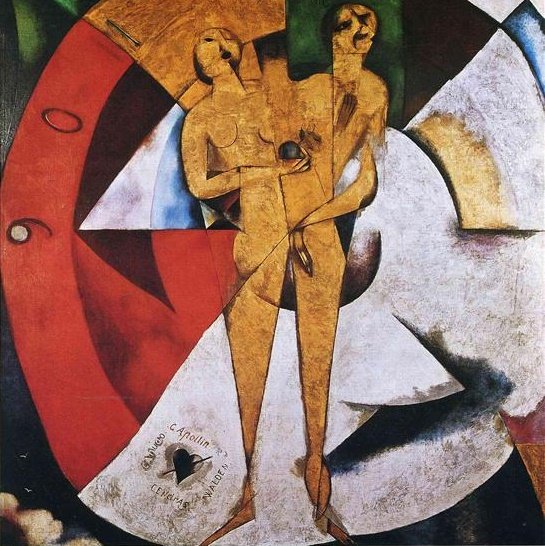
Because of its relevance for modern and contemporary poetry, "Zone" has been a poem that has had many notable interpretations; one that I especially appreciate is that of Ulalume González de León, from whom we have used the translation of "Zone". So I will only synthesize ideas already contributed by critics.
"Zone" is written in the manner of the "free flow of consciousness", as modern psychology would say (a modality that in narrative was called "interior monologue"), that is, it is the mental discourse of a speaking subject -in this case it could be identified with the poet Apollinaire himself- who begins his walk through Paris in the morning, and in that present there will be temporal intercalations, whether of the past in the form of memories or evocations -childhood, mother, friend, school, church, loves-, or of an imagined future. But also spatial juxtapositions, perhaps to the extent that the passage through certain places allows the association or imagination of other spaces not present, or with symbols and objects very typical of the civilization in progress for that time (for example, the relation of the elevation of Christ with the flight of an aviator and of multiple birds).
The poem closes when the poetic subject returns home, as the day is closing. And he does so with a phrase that has transcended to our days: "Sun cut neck" ("Soleil cou coupé", with a more effective alliteration in the original French). I completely agree with Friedrich's interpretation: it alludes to the setting of the sun, only the image is so arbitrary and suggestive that it throws us off, which is what interested Apollinaire.
It has been determined that the version of the poem entitled "Zone" (formerly "Cry") is from 1912. Apollinaire's poem would then be a sort of prelude to James Joyce's novel Ulysses, which takes place in one day and in which the character - Leopold Bloom - presents his vision of his tour of Dublin in one day (as similarly in "Zone"), published in 1922 and taken as the landmark of the interior monologue (along with Virginia Woolf).
In this space-time game in the mind of the poetic subject where desires, afflictions, fantasies, etc., come together in apparent disconnection, the elision of punctuation marks, the splicing of sentences without syntactic nexus, the chaotic enumeration, among other resources, that Apollinaire puts into practice (perhaps contemporary to futurist proposals, or applying to the word the contributions of cubism), play a major role.
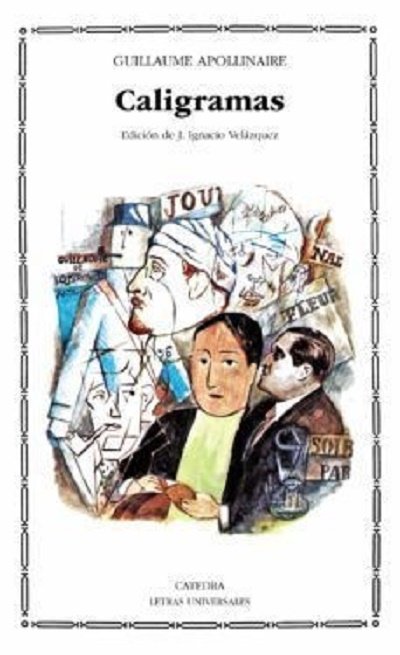
Caligramas
Caligramas (https://es.wikipedia.org/wiki/Caligramas_(Apollinaire)), que curiosamente fuera titulado como “poemas de la paz y de la guerra”, es un libro heterogéneo (como lo fue Alcoholes), no solo en lo temático, sino, particularmente, en lo formal. Encontramos poemas del modo tradicional, del estilo simultaneísta y en lo caligramático.
A este libro pertenece uno de los poemas de especial talante simultaneísta, “La ventanas”, pero es un poco extenso para ponerlo aquí (podrán acceder a él en un enlace que colocaré al término de mi posts). Solo reproduzco parte de su final:
Del rojo al verde todo el amarillo muere
París Vancouver Hyeres Maintenon Nueva York y las Antillas
La ventana se abre como una naranja
El hermoso fruto de la luz
============
Calligrams
Calligrams (https://en.wikipedia.org/wiki/Calligrammes), which curiously was titled as "poems of peace and war", is a heterogeneous book (as was Alcohols), not only thematically, but particularly formally. We find poems in the traditional way, in the simultaneist style and in the calligrammatic.
To this book belongs one of the poems of special simultaneist mood, “The Windows”, but it is too long to put it here (you will be able to access it in a link that I will place at the end of my posts). I only reprouce part of its ending:
From red to green all the yellow dies
Paris Vancouver Hyeres Maintenon New York and the Antilles
The window opens like an orange
The beautiful fruit of light
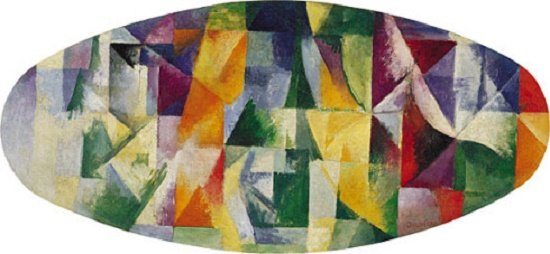
Pero lo más trascendente de Caligramas es la actualización de una forma poético-gráfica que había quedado casi olvidada, donde se integra el ideograma (las ideas se representan mediante una figura, signo o carácter) y la caligrafía (“escritura hermosa” vendría a ser una traducción aproximada), creando un tipo de poema en el que se funden una atractiva escritura con el signo visual del ideograma (Benko). Solo puedo reproducir algunos de las versiones originales.
But the most transcendent of Caligrams is the updating of a poetic-graphic form that had been almost forgotten, where the ideogram (ideas are represented by a figure, sign or character) and calligraphy ("beautiful writing" would be an approximate translation) are integrated, creating a type of poem in which an attractive writing merges with the visual sign of the ideogram (Benko). I can only reproduce some of the original versions.
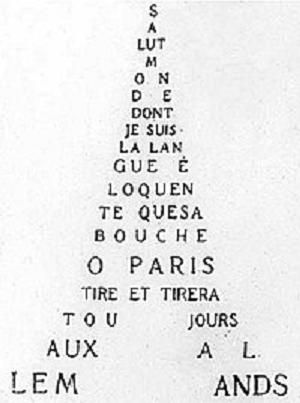
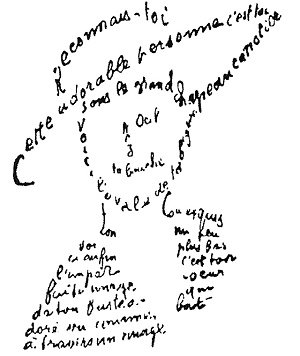
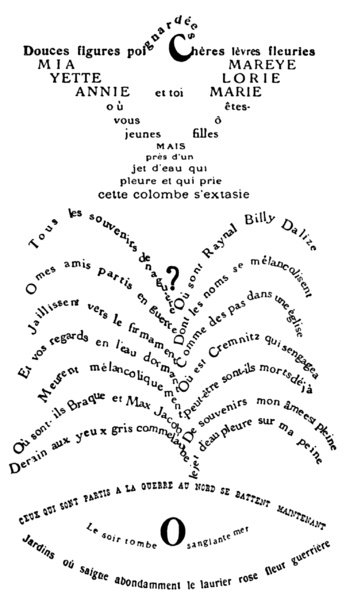
(Puede encontrar más caligramas de Apollinaire en este enlace) | (You can find more of Apollinaire's calligrams at this link).
Esta forma, que fuera usada en la poesía de habla hispana por Vicente Huidobro, José Juan Tablada y Octavio Paz, entre otros poetas, ha quedado, por razones casi obvias, en el pasado, si se toman en cuenta los avances digitales en las redes.
This form, which was used in Spanish-language poetry by Vicente Huidobro, José Juan Tablada and Octavio Paz, among other poets, has become, for almost obvious reasons, a thing of the past, if we take into account the digital advances in the networks.
============
Referencias | References:
Benko, Susana (1993). Vicente Huidobro y el cubismo. Caracas: Monte Ávila Editores - Fondo de Cultura Económica.
Friedrich, Hugo (1974). Estructura de la lírica moderna. España: Seix Barral Editores.
Paz, Octavio (1985). Los hijos del limo / Vuelta. Colombia: Edit. La Oveja Negra.
Raymond, Marcel (1983). De Baudelaire al surrealismo (1ª reimpresión). España: Fondo de Cultura Económica.
============
Una excelente selección de la obra poética de Apollinaire pueden leerla aquí.
A short selection of Apollinaire's poetic work in English can be read here.

Gracias por su lectura | Thank you for reading.



Esta publicación ha recibido el voto de Literatos, la comunidad de literatura en español en Hive y ha sido compartido en el blog de nuestra cuenta.
¿Quieres contribuir a engrandecer este proyecto? ¡Haz clic aquí y entérate cómo!
https://twitter.com/jorma08/status/1512117257572339712
The rewards earned on this comment will go directly to the person sharing the post on Twitter as long as they are registered with @poshtoken. Sign up at https://hiveposh.com.
Me encantó esta serie sobre Apollinaire, muy interesante el análisis de Zona y de Caligramas. Hay una versión de Le pont Mirabeau recitada por el propio Apollinaire, ¿la escuchaste alguna vez? Se puede encontrar en internet. No es la primera grabación de un poeta recitando sus poemas, ¡pero tiene más de un siglo! Es muy interesante escuchar el ritmo que Apollinaire le daba a su poema (en mi caso, lo encontré muchísimo más lento de lo que me imaginaba). ¡Saludos!
Muy agradecido por tu atenta lectura y tu apreciación, @agreste. Creo haber escuchado esa grabación del recitado de "Le pont Mirabeau", si no me equivoco. De todos modos la buscaré. Es curiosa la experiencia de escuchar leer sus poemas al propio autor; a veces no me ha gustado; incluso algunas personas pueden llegar a leerlos mejor que el propio poeta. Saludos, amigo.